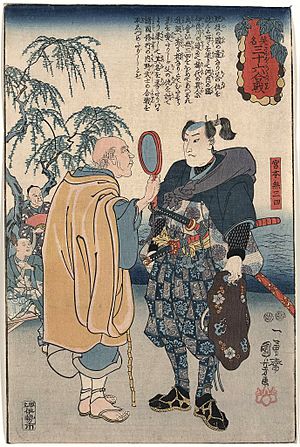Rōnin facts for kids


In ancient Japan, from about 1185 to 1868, there were brave warriors called samurai. These samurai usually served a powerful leader, known as a lord or master. But sometimes, a samurai lost his lord. This could happen if the lord died, lost his power, or if the samurai lost the lord's trust. When a samurai no longer had a master, he became a rōnin (pronounced ROH-nin).
The word rōnin means "drifter" or "wandering man." It's like someone who is a "person of the waves," floating without a fixed home. Today in Japan, the word rōnin can also describe a student who hasn't been accepted into university yet, or someone who is unemployed.
Contents
What is a Rōnin?
The word rōnin comes from two Japanese words: rō (浪) meaning "wave" or "unrestrained," and nin (人) meaning "man" or "person." So, it literally means "wave man," showing someone who is socially adrift, like a boat without a home port.
This term first appeared a very long time ago, during the Nara and Heian periods (around 710 to 1185 AD). Back then, it described a farmer who had run away from their master's land. Later, it became the word for a samurai who had no master.
Life as a Rōnin
Samurai followed a strict code called Bushido, or the "Code of the Warrior." This code said that if a samurai lost his master, he should perform seppuku, a ritual suicide. If a samurai chose not to do this, he would become a rōnin. Being a rōnin was often seen as a great shame by other samurai and powerful lords called daimyō.
Like other samurai, rōnin usually carried two swords: a long one and a short one. They also used other weapons. Some rōnin who didn't have much money might use a bō (a long staff) or a jō (a shorter staff or walking stick). They might also use a yumi (a bow). The weapons they used often depended on the martial arts school they had learned from.
Rōnin in Different Eras
During the Edo period (1603–1868), the number of rōnin grew a lot. This was because the government, called the shogunate, had very strict rules about social classes. Samurai were not allowed to easily change masters or even change their jobs. They also couldn't marry people from different social classes as easily as before.
If a lord's land was taken away by the shogunate, all his samurai would become rōnin. Since they couldn't legally get new jobs, many rōnin had to find other ways to make a living. Some became mercenaries, guarding trade groups or rich merchants. Others became criminals, like bandits or thieves.
Before the Edo period, especially during the Sengoku period (around 1467–1615), things were different. Lords needed many fighters, so a rōnin could often find a new master. The bond between a lord and his samurai was not as strict. Many warriors served several masters, and some even became powerful lords themselves. For example, Tōdō Takatora served ten different lords! Also, people could change their jobs more easily, so a warrior could become a merchant or a farmer, and vice versa.
The Rise and Fall of Rōnin Numbers
As Japan became more unified, lords didn't need as many soldiers. After a big battle in 1600, many lords lost their lands, and a huge number of samurai became rōnin. About 100,000 rōnin even joined forces to fight in a major siege.
In the peaceful years that followed, there was less need for large armies. Many rōnin became farmers or moved to towns. Some, like Yamada Nagamasa, even traveled overseas to work as mercenaries. But most rōnin lived in poverty. At one point, there were almost half a million rōnin in Japan!
The government first saw rōnin as dangerous. They were often banned from cities or forced to live in special areas. They were also not allowed to serve new masters. This made life very hard for rōnin, and some even joined a rebellion in 1651. This made the government change its mind. They made it easier for lords to keep their lands and allowed rōnin to find new masters.
Being a rōnin was generally not a good thing. It meant you had no regular income or land, and people often looked down on them. In the 1800s, the emperor ended the samurai class completely. With that, the special status of rōnin also disappeared.
Famous Rōnin
- Forty-seven Rōnin: A famous group of rōnin known for their loyalty.
- Miyamoto Musashi: A legendary swordsman and writer.
- Sakamoto Ryōma: A key figure in the period leading to the end of the samurai era.
- Yamada Nagamasa: A Japanese adventurer who became a leader in Southeast Asia.
See also
 In Spanish: Rōnin para niños
In Spanish: Rōnin para niños
- Gonin Gumi – Groups of households that worked together for protection, sometimes against rōnin.
- Knight-errant – A similar type of wandering warrior found in Western stories.
- Youxia – A similar type of wandering hero in Chinese culture.
- SHINSENGUMI – A special police force from the late Edo period.

